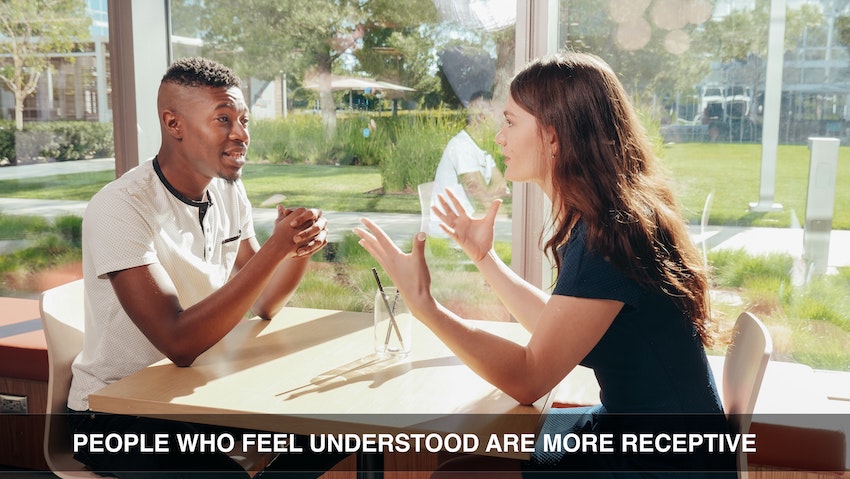Firm But Fair Leadership
Learn To Lead with Strength and Compassion
Refine your communication skills by learning to harness your emotional intelligence with one of the UK's most acclaimed management training courses.
Why Choose This Training?
More Than Just A Course Of Lectures
What gets in the way of developing and holding on to new communication skills are old habits of thinking and speaking. Even if the advice is very good the reason why it rarely sticks are the mental habits people inevitably revert to, especially under pressure.
Unlearning those old habits and internalising a more effective and lasting approach to communication needs more than a short course of lectures on how to do it.
What Makes This Training Stand Out?
What makes this training stand out is the exceptional support through one-to-one coaching sessions and continuous feedback. Changing behaviour is not an easy task as old habits are hard to break.
With a 40-year track record we can help you cultivate practical skills, and build your confidence to so you can successfully navigate real-world challenges, ensuring lasting behavioural improvements.
Testimonials
Join thousands of participants getting results
"What I love about this course is that I didn't just learn about the topic, this course is about ME. I'm confident I can reliably use my new skills, even when under pressure".
![]()
"A lesson for life! The power of effective communication is incredible when one masters the skills "listening with empathy" and "speaking assertively"
![]()
Clients We Have Worked With
Well-known companies who have used this course again and again, over many years
Course Summary
Training Objectives
This course is designed to help you develop your leadership skills by adopting a "firm but fair" approach. It emphasises the importance of finding a balance between assertiveness and fairness when managing people in a professional setting. By establishing clear expectations and effectively communicating them to your team, you can create a framework for accountability and enhance overall performance. Consistency in disciplining and treating employees equitably is crucial, ensuring that rules and consequences are applied fairly without favouritism. Active listening and empathy play a significant role in building strong relationships and addressing employee concerns effectively. This course focuses on providing constructive feedback to help you grow and develop professionally. By mastering the "firm but fair" leadership style, you can foster a positive and productive work environment that boosts morale and trust within your organisation.
Emotional Intelligence
You will learn a set of powerful emotional intelligence communication techniques so that you can manage difficult conversations, handle challenging situations, build relationships and set firm boundaries.
Transferable Skills
The goal of this training is to equip you with the tools they need to build strong, lasting relationships in your professional life, although because these skills are so transferable many clients report vast improvements in their personal relationships as well.
Develop Skills
This is a skills development rather than just a theoretical programme, so the emphasis throughout will be on you taking turn after turn, practising your skills, while receiving feedback and coaching about your effect on others.
Repeated Practice and Feedback
In your coaching sessions you will be helped to practise dealing with the kinds of situation you find challenging, again and again, until you are confident you can do it successfully.
Video Analysis
We'll combine practical, hands-on experience with video replay and analysis and discussion of the principles involved to help you gain both skills and understanding. Special attention is paid to your individual training needs, so you can practise your skills in real-life situations that you have to handle at work.
Sustained Change
That's why as well as your place in a small group, this training includes a generous amount of private and confidential one-to-one coaching sessions online, spread over several months, ensuring an exceptional level of support. This will ensure the changes you make are sustained over a longer period of time and any obstacles are overcome. Choose between online training available worldwide, or in-person face-to-face courses in the UK.
Course Dates and Price
For a list of upcoming course dates (for online coaching and face-to-face training), the locations of the next 3-day public courses in the UK and pricing Click here.
Free Initial Session
This initial coaching session serves as an introduction to the "Skills with People" course, allowing you to understand the course's relevance and effectiveness for your specific needs before committing to it.

Learning Objectives
The learning objectives on this course are to help you become a firm but fairl leader. Firm but fair leadership is an effective style of management which requires setting clear expectations and boundaries. It implies having established standards and holding employees accountable for meeting them, but also providing them with all the time and resources needed to succeed.
By employing emotional intelligence and communication skills, authoritative leaders provide employees with a sense of structure while promoting collaboration among teams.
Leaders who play it firm but fair strive to achieve great outcomes on one hand, while imparting elements of trustworthiness on the other making their team feel valued.
- Firm but fair leadership combines authority with empathy and seeks to create a workplace where employees feel valued.
- It is important for leaders to set clear expectations and boundaries while also offering flexibility in order for team members to voice their opinions.
- Engaging in self - reflection and communication skills helps build trust among the team, enhancing productivity and morale, as well as reducing turnover rates.
- Successful firm but fair leaders have shown how strong teams can be formed through showing compassion coupled with holding people accountable - resulting great outcomes achieved over time.
Understanding Firm But Fair Leadership
Firm but fair leadership demands a balance of authority and empathy, setting clear expectations and boundaries for employees to ensure a productive, healthy workplace.

Defining the Concept of Firm Leadership
Firm but fair authoritarian leadership is a form of authoritative authoritarian leadership, which involves maintaining a balance between the two distinct elements of firmness and fairness.
Firmness enables a leader to be in control, guide their team members effectively through direction and structure, while making sure that everyone understands their roles and responsibilities within the organisation.
Fairness allows leaders to be empathetic towards employees’ needs, provides employee feedback without prejudice or personal standards, takes into consideration changes affecting them personally or professionally.
Leaders who are able to practice firm but fair leadership find success with increased productivity in order to achieve great outcomes through employee compliance as well as improved worker morale due to appreciating high quality performance from individuals on the team.

Balancing Authority With Empathy
Leaders must combine the firmness of authority with emotional intelligence to remain fair and ensure that their teams or organisations progress. For this, actively listening to their team members helps them understand each individual’s perspective better.
This allows leaders to create a workspace where direct reports are not scared of approaching them due to any fear of unfair treatment. It is also important for managers and supervisors encourage positive behaviour within the organisation while also having clear rules in place should an employee deviate from expectations.
Creating an open workplace culture improves collaboration among employees as they gain trust in their manager or leader by understanding that they will be judged fairly which leads them feeling safe enough to voice opinions and brainstorm ideas freely.

Setting Clear Expectation and Boundaries
Firm but fair leadership requires the leader to clearly express expectations and establish boundaries for team members. A well-defined set of expectations helps employees understand what is expected of them while also setting a high standard.
This allows authoritative leaders to achieve great outcomes without simply relying on commands and orders but rather providing guidance with clarity so employees can comply affirmatively.
It's important for leader's to allow enough flexibility within their guidelines so employees can give input and feedback throughout any process or decision making cycle. This keeps every team member engaged while empowering each person to take cultural ownership over forthcoming tasks, resulting in higher quality end performance from all involved parties.
Leaders applying a firm but fair attitude means not micromanaging. Instead they lead by example, collaborating respectfully with colleagues along the way imparting essential elements such as accountability. Respectfulness and secure feelings through building trust and understanding will get you far with any group. Often it may sound simple, yet it takes time and patient practice to learn how to honour other people when you’re worried about whether they’ll do as good a job as you would if you don’t delegate.

The Benefits of Firm But Fair Leadership
Firm but fair leadership styles can provide significant benefits such as increased productivity, improved morale, reduced turnover rates, and better communication.
Enhanced Productivity
Firm but fair leadership encourages employees to perform better by setting clear expectations and maintaining a healthy balance between authority and empathy. The idea is to impart a sense of accountability while enabling positive, productive relationships with team members.
Leaders should ensure that their employees have the necessary resources they need to reach goals, provide constructive feedback when needed, and reward positive behaviour whenever possible.
This gives employees a greater sense of purpose as well as trust in their leader's judgment, which is important for motivating them to work hard towards good outcomes. Firm but fair leaders must prioritise self-reflection and stress the importance of effective communication skills rather than relying on strict enforcement or punishment alone.
Improved Employee Morale
Firm but fair leadership is essential for creating a work culture where employees are valued and appreciated. Leaders must be assertive, open, and transparent in their communication with team members while leading by example to ensure morale remains high.
By balancing authority with empathy, good leaders can create an environment that encourages improved performance as well as fostering loyalty.
Good firm but fair leaders are skilled in emotional intelligence and understand the importance of constructive feedback, rewarding positive behaviour promptly, addressing issues professionally, not only easing tensions but also helping to build trust within the organisation.
Authoritative leaders can also set clear expectations and boundaries while catering these rules to suit individual team members whenever possible according to their abilities. This way they can be more confident in winning employee compliance, as they won’t have to pressurise them or threaten them, which would lead to resentment more than anything else.
These strategies automatically establish an atmosphere where expressing ideas helps bring about change instead of feeling stifled under strict management politics or tactics. With everyone taking part in decisions being made, it can create a transformational atmosphere within the company. A good leader can culminate a positive atmosphere which can lead to increased job satisfaction along with enhanced productivity retention rates as well.
A good example of a successful leader using firm yet firm but fair means leading teams towards great outcomes was former US President Abraham Lincoln who emphasised team spirit over doing everything at one’s own discretion. His humble attitude earns him the respect from staff both during the civil war era and afterward, when he lead through tough times. Even though it might sound simple, it is difficult to put into practice consistency. On this training course you’ll learn how to use these skills, and receive lots of practice, guidance and feedback until you’re confident you can do it well.
Reduced Turnover Rates
The importance of a reliable and dedicated workforce is essential in order to be successful. This is why firm but fair leadership is so important in reducing employee turnover rates, as it helps create an atmosphere of trust and loyalty between authoritative leaders provide employees and followers.
Leaders who practice firm but fair leadership encourage their employees with clear expectations and boundaries, while also listening to feedback and rewarding positive behaviour.
Examples of successful leaders who have implemented these strategies include Abraham Lincoln, Nelson Mandela, Angela Merkel and Satya Nadella.
To further reduce turnover rates within an organisation, authoritative leaders provide their staff with the opportunity for growth through clarifying job security, as well as offering rewards. These may include training for advancement opportunities like promotions, or skills development classes as a way of demonstrating how much they are valued. A good leader will want to show their team support, and that they are willing to invest in helping them reach their goals and personal milestones.
Better Communication
Effective communication is key to achieving great outcomes with firm but fair leadership. Leaders who are authoritative and provide clear expectations create sound simple plans for employees. A good leader will be able to demonstrate compassion, care and respect on the one hand, and authority mixed in with a willingness to enact change when necessary on the other.
Good communication helps build trust between both leaders and employees at an organisation. By maintaining open channels of dialogue that enable transparent two-way discussions such as providing good quality feedback (both praise and criticism), team members are much more likely to do their best work. Additionally on this course you’ll learn how to use assertiveness as a critical goal setting tool. With strong emotional intelligence skills you can learn to be firm but fair, and leading your team into towards successful outcomes without needing to threaten them with negative talk.

Techniques For Executing Firm But Fair Leadership
Firm but fair leadership requires a combination of skill and practice, including the use of emotional intelligence, communication skills, rewarding positive behaviour, providing constructive feedback, and leading by example.
Emotional Intelligence And Communication Skills
Emotional intelligence and communication skills are two of the most essential components for effective firm but fair leadership. Empathy, self-awareness abilities, and strong social skills are all valuable characteristics that allow leaders to build relationships with their team members and understand their needs better.
It is critical for an authoritative leader to be able to interpret colleagues emotional states accurately in order bring out the best performance from them.
For example, a leader who is aware of his or her own emotions can better manage any negative feelings when giving feedback or confronting challenging practices within a team.
This ability will help diffuses tension by understanding how the situation might affect people. They can then ensure they provide constructive criticism without provoking other people into becoming defensive. They can make sure they are offering rewards that are more likely to motivate their company and staff, and are tailored appropriately for each individual. They can provide an environment where open communication between team members is encouraged, and free from bullying or judgmental behaviour from colleagues.
Providing Constructive Feedback (Criticism) Safely
Constructive feedback is an essential element of firm but fair leadership. By providing employees with clear and directed pointers on how they can improve their behaviour or performance, leaders are able to foster a culture of continuous development while remaining consistent in their demands for high quality results. Constructive employee feedback offers multiple benefits including improved productivity, better communication, improved employee morale, and reduced turnover rates.
To deliver effective feedback requires an understanding that positive reinforcement should be at the centre of any interaction. It is also important to focus on specific behaviours rather than making judgements and generalisations, as this will make it easier for the recipient to accept your feedback without feeling judged personally. On this course you’ll learn how to offer other people your feedback about the “effect” their behaviour has on you. It helps if you can be emotional about it. It may sound counter-intuitive, but it can be extremely help to explain what you like, and what you don’t like about someone else’s performance. They can then either work out for themselves, or you can assist them to plan actionable suggestions for improvement will help ensure that they learn from your input and can improve.
Successful examples of powerful yet compassionate people who have incorporated constructive criticism into their management style include Abraham Lincoln, Nelson Mandela, Angela Merkel , and Satya Nadella . All four emphasised being both loving and objective when discussing team progress or mistakes. They strove to teach people by presenting alternative perspectives and policies which could shift behaviour without damaging relationships long-term. However, you don’t have to be as high powered, or as famous to be able to learn to do what they did. On this course you’ll learn how to be more like them.
Rewarding Positive Behaviour
Reward and recognition systems are an invaluable way to reinforce values and beliefs within an organisation. This is especially true when it comes to firm but fair leadership, as it helps bring about a positive team atmosphere that encourages productive output from employees.
Rewards can range from verbal praise or public acknowledgment of exceptional performance to tangible gifts, such as gift cards, monetary rewards, flexible days off or even promotion opportunities if the work done merits it.
These types of rewards act as incentives for staff members, encouraging productivity and can be uplifting in times of low morale. A good leader should recognise individual greatness along with collective efforts among the team and reward accordingly for impressive performances.
An effective reward system must quantify goals and set clear expectations that people can strive towards achieving. This strikes a balance between having a clearly defined standard for achievement while still offering enough room for self-expression and innovation for ambitious team members.
Addressing Issues Promptly And Professionally
Addressing issues promptly and professionally is an essential part of firm but fair leadership. Good leaders take the time to become aware of existing issues (whether they are organisational, interpersonal or work-related), address them rapidly and responsibly, and ensure that their team leaders underneath them understand the importance of dealing with any problems quickly and effectively.
When a leader addresses issues promptly in consistent manner, it demonstrates respect for their team members, and it shows they care about resolving potential conflicts quickly so as not to disrupt working flow.
Doing this also encourages employees to trust their leaders because people feel like their opinion are truly valued.
In order to handle issues appropriately without letting their emotions cloud our judgement, good leaders must possess emotional intelligence, being open-minded enough to empathise with different opinions while remaining assertively offering their feedback when necessary.
Leading By Example
Leading by example is at the heart of firm but fair leadership. Leaders who are successfully firm but fair demonstrate consistency and fairness in their decisions, communication style, work-ethic, relationships with the team and attitude to adversity.
They also have a strong understanding that abiding by certain standards reinforces an organisation’s core values and beliefs.
Leaders can promote effective change management initiatives across the organisation when they role model desired behaviours among team members. Even if it’s just something as small as engaging in friendly conversation, or refraining from gossip these efforts towards reinforcing organisational culture can pay off greatly in terms of creating a positive office environment where everyone works together harmoniously to reach common goals.

Different Types Of Leadership Styles
Different types of leadership styles, like authoritative/visionary , transformational and Democratic can all incorporate elements of "Firm but Fair" to achieve great outcomes.
Authoritative Leadership Or Visionary Leadership Styles
Authoritative leadership is a type of management style in which a leader sets clear expectations for their team and provides support when needed. It relies on setting boundaries as well as being firm but fair when dealing with employees, while also showing understanding and compassion.
This form of leadership is based around establishing trust between the boss and employees by treating them with respect and offering confidence to help spur motivation. Visionary leadership involves inspiring people towards a shared goal or vision through innovative thinking, charisma, influence, and openness.
These leaders foster collaboration among staff members to nurture creativity while also having strong communication skills, an ability to motivate others despite challenges, and expertise in decision-making processes.
Both authoritative leadership styles and visionary leadership styles can be used effectively in creating a firm but fair environment that helps achieve great outcomes through employee compliance without alienation from imposing too strict of regulations.
In practice it looks like providing concrete feedback that shows recognition of effort rather than just focusing on results. It utilises constructive discipline techniques, rewards behaviours instead of punishing mistakes, addresses issues promptly yet professionally, leads by example, and empathises with personal situations where appropriate.
By combining these strategies into one balanced approach it's easier for both bosses (who receive more cooperation) and employees (who feel respected).
Transformational Leadership Style
Transformational leadership is a unique leadership style focused on an individual's ability to motivate, inspire and encourage change. It involves having the insight to engage employees in a meaningful way by conveying a sense of excitement through shared purpose for the greater good of organisations.
Transformational leaders not only create real transformation within their organisations, they also enact change within those who follow them.
A successful transformational leader firmly believes that people need something more than just guidelines or instructions from authority. They must be passionate about their work and passionate about each other and organization's success.
They focus on building trust with those under them by encouraging open communication, and engage everyone in solving problems collaboratively. They create workplace harmony where everyone feels valued, appreciated and rewards and results are celebrated, and high quality performance from team members is easily acknowledged.
Servant Leadership Style
Servant leadership is a unique style of leadership that puts the focus firmly on helping others to succeed. This type of leadership aligns well with most modern organisation’s core values, such as teamwork, collaboration, integrity, respect and humility.
A key defining characteristic of servant leaders is that they trust their team members and actively seek out feedback from them in order to shape ways forward for the collective good.
The benefits of implementing a servant leadership mentality include improved employee morale through greater sense of ownership, increased team loyalty due to building strong relationships between management & subordinates, reduced staff turnover due to establishing clear expectations from employees early on, and better communication resulting from active listening by the leader which leads into more dedicated workers day-to-day activities.
Democratic Leadership Style
Democratic participative leadership offers members of a group equal opportunity to exercise input when making decisions. This style is also called participative leadership and it places the team’s focus on mutual understanding, shared values and collaborative problem-solving.
Democratic leaders usually make decisions through consensus building, allowing everyone in the group to have an active role in reaching the solution at hand.
They encourage open communication among all members and invite contributions from those who may lack confidence or experience. By involving people in decision-making processes, democratic leaders help create higher commitment towards desired outcomes while simultaneously promoting supportive team relationships that foster collaboration instead of competition.
This type of participative leadership works best not only as an effective way to manage teams but also for making improvements within organisations by increasing overall motivation levels throughout its hierarchies via empowerment strategies that let staff pursue their own ideas as part of initiatives.
The greatest advantage with this approach is that everybody contributes their individual talents and skillsets which helps increase morale during tasks. There tends to be better quality control due to diversity and innovation due to greater interconnectivity as teams work together collaboratively than they would under authoritative leader or autocratic regime settings where one person rallies up orders for each member. Here “the wisdom of crowds” theory wins out, and collective intelligence outplays focused expertise.

Challenges Of Firm But Fair Leadership
Developing a balanced style that is firm yet fair is one of the most difficult tasks for any leader, as it requires acknowledging both accountability and compassion.
Balancing Compassion And Accountability
As effective leaders, it's essential to strike a delicate balance between compassion and accountability. Too much of either will result in an ineffective working environment where team members are not motivated or able to deliver results.
A compassionate leader understands their people’s needs but also holds them accountable for their actions. Such a leader is willing to listen and have empathy towards their staff while still holding them responsible for meeting expectations.
To create a successful balance between these two traits, good leaders start by setting clear boundaries and expectations that apply equally across all teams and individual employees.
Establishing these from the beginning ensures that everyone knows what is expected of them without feeling like they're being micro-managed or reprimanded unnecessarily if they make mistakes along the way.
Providing positive feedback when tasks have been achieved encourages mutual respect among team members, while encouraging ownership over challenges faced on projects regardless of size or difficulty.
By acknowledging effort both directly through recognition programs such as rewards or bonuses as well as indirectly via initiatives such as flexible work hours - encourage problem-solving skills across departments with tangible results benefiting organisation overall.
Leadership examples are many: Abraham Lincoln led his country during one of its most turbulent periods while Nelson Mandela secured freedom from discrimination through sheer dedication powered negotiation patient collaboration.
Dealing With Conflict
Effective leadership requires more than just communication and of course, is not always easy. Leaders have to make hard decisions that can lead to disruptive workplace conflict.
One very important practice for leaders looking to handle insecurity and dissent amongst their people is maintaining clear boundaries while still demonstrating empathy towards team members. This way employees know what is expected and accepted within your organisation's culture, such as job breadth or performance expectations, while still feeling respected by their leader when making mistakes.
Boundaries should be set politely yet firmly around non-negotiable items. This could mean issues such as policies, rules & regulations that everybody must adhere to. If someone breaches these then consequences must follow which helps employees understand there are lines that cannot be crossed all the time.
Handling Resistance
Firm but fair leadership is essential for managing resistance from employees in times of change. To be successful, leaders must employ active listening techniques and demonstrate empathy to understand underlying employee motivations.
It is also important for the leader to provide clarity on expectations and maintain consistency in actions and words. For example, a manager could communicate the importance of changes or new policies with emotional intelligence, instead of merely imposing them. This way, employees can better understand why they are taking place from an authoritative figure which is likely to ensure better compliance without sacrificing morale.
Having firm but fair leaders help bridge the gap between authority and respect among colleagues ensures that teams will not only develop understanding about any imposed rules or regulations, but they will also think positively towards their management. Thanks to an influencing attitude based on trust-building rather than fearmongering they are much more likely to accomplish better outcomes.

How To Develop Firm But Fair Leadership Skills
When striving to develop firm but fair leadership skills, leaders should focus on encouraging active listening, practicing self-reflection, prioritising empathy, and being assertive instead of aggressive.
Seeking Feedback
Seeking feedback is an essential part of developing firm but fair leadership skills. Feedback helps leaders to identify areas for improvement in order to develop their communication, decision-making, and performance management skills. Asking others for constructive criticism gives leaders the chance to make adjustments in order to be better equipped with the skills necessary for successful leadership.
There are several techniques that leaders can use when seeking feedback:
1) Ask direct questions - Confident leaders ask specific questions about their performance as well as situations they have faced or responded to. This provides a clear personal growth opportunity and enable them to reflect on any possible mistakes they may have made and learn from them.
2) Make it a two-way process - When communicating with those in the organisation who would like feedback or direction, it’s important that both parties feel comfortable exchanging ideas honestly and openly without judgment or fear of repercussions. A good way of achieving this is being comfortable sharing praise. By focussing on what you like, admire or respect about the other person they are likely to feel respected and valued, and are more likely to reciprocate with useful feedback and direction.
3) Listen actively and respond thoughtfully - Active listening means being completely present in a conversation, hearing without bias what others are saying, not trying to defend oneself from negative remarks, being able to read between lines if needed, taking advice onboard even if one does not agree initially. Responding thoughtfully involves recognising past beliefs/ behaviours which do not match up with current ones, and making appropriate changes where needed. It may also include deciding how best one can incorporate new knowledge into everyday practices
Practicing Active Listening
Active listening is essential for effective communication, and helps leaders foster trust and understanding among team members. As a firm but fair leader, it's important to be an active listener and remember that the goal is not only to hear what your employees are saying but also to really listen so that you can understand their perspectives.
When practicing active listening skills good leaders use open use empathy to encourage other people to explore concerned people might have, frustrations they may have encountered, and worries for the future. These types of empathetic questions and statements help ensure that all opinions are heard and they provide deeper insight into what the speaker may be feeling or thinking during a conversation.
Paraphrasing back what has been said is another way to show more active listening. For example, briefly summarising someone’s points with phrases like: “It sounds like what you’re saying is …”, or stating with empathy, “You sound unhappy to about …” This technique ensures an level of understanding most other people tend to find irresistible, and will prove to the other person know how much attention you are giving them. On this course you’ll learn exactly how to do this really well.
Providing feedback in regards to their opinion shows respect for each person which creates trust, enabling them to bring up issues. This make is much more likely you’ll be effective, and is likely to result in better solutions through consensus building.
Prioritising Self-reflection
Self-reflection is key tool to developing firm but fair leadership strategies. By taking the time to reflect on one's personal experiences and values, leaders are able to better recognise their own strengths and weaknesses in order to develop more effective practices.
This kind of self-analysis can also help leaders become more aware of how their decisions may impact those around them, which allows them to enact changes that promote greater team unity and trust.
For example, renowned civil rights activist Nelson Mandela spent much of his 27-year incarceration on Robben Island immersed in internal reflection before he was released from prison - a process that facilitated his successful transition into political activism and eventual presidency of South Africa.
Abraham Lincoln similarly believed the best way forward for any situation required periods of introspection, often spending hours alone walking or reflecting before announcing potentially polarising decisions.
In today's business world, it remains essential for good leaders to prioritise self-reflection in order cultivate meaningful relationships with employees, customers and shareholders. You will be much better at tuning in to understand the needs both inside and outside an organisation.
Being committed to growth and development helps empower teams by driving home the idea everyone is capable striving towards excellence no matter what background or seniority they have within an organisation.
Emphasising Empathy
Emotional empathy is an essential tool for any leader looking to foster a positive work environment and inspire and motivate their team. This trait allows the leader to focus on understanding people’s feelings, giving them licence and commitment to engaging emotionally with their peers in order to better understand them and build trust.
Empathy establishes a bond of mutual respect between leaders and employees which encourages open communication, allowing teams to air concerns and discuss ideas more freely without fear of judgement or punishment.
Leaders that apply emotional empathy when interacting with their team can provide clear feedback, show compassion under pressure situations, offer constructive criticism as well as praise achievements while maintaining firm rules within the workplace boundaries.
Examples of highly empathetic leaders include Abraham Lincoln, Nelson Mandela and Satya Nadella. They have all have been successful leaders apply themselves in energising their teams through emotional intelligence.
Emphasising empathy is essential for getting staff involvement which helps bring out high quality performance from employees thus ensuring success in leading objectives while implementing lasting change throughout the organisation.
Being Assertive Instead Of Being Aggressive
Being assertive is an essential part of exhibiting firm but fair leadership styles. An assertive leader has the ability to express their opinions in a confident yet non-confrontational way, as opposed to aggressive or passive behaviour which tend to produce counterproductive results.
Assertiveness entails finding a balance between passivity and aggression, in which one can ask for what they want firmly and fairly.
Examples of successful leaders who demonstrate how being assertive instead of aggressive is critical component include Abraham Lincoln who was able to effectively manage the U.S Civil War using words as his weapon rather than violence. Nelson Mandela promoted conflict resolution through dialogues while opposing Apartheid. Satya Nadella of Microsoft whose empathetic leadership drove technological advancement around the globe. Angela Merkel exemplified strong decision-making despite domestic opposition amidst global crises like Brexit or Syrian refugee crisis. All these examples prove that it's possible to achieve great outcomes if you can embody respect and understanding within your team whilst still having clear boundaries on how circumstances should be managed. It may sound simple but this ability requires patience along with emotional intelligence, communication skills and empathy. On this training course you’ll learn exactly how to do it.

Examples Of Successful Firm But Fair Leaders
Examples of successful firm but fair leaders include Abraham Lincoln, Nelson Mandela, Angela Merkel and Satya Nadella.
Abraham Lincoln
Abraham Lincoln's brand of leadership style is legendary for its ability to balance firmness and compassion. He was an effective transformational leader who acquired the trust, loyalty and respect of his followers with his values focusing on justice and fair treatment.
On one hand he acted as an almost authoritative leadership figure when it came to setting boundaries in order to enforce compliance, while on the other, he knew how to connect emotionally by showing indication of caring deeply about his people.
For example, once during the American Civil War, Lincoln visited several Union army hospitals instead of conducting business - a conscious decision which showed just how deeply he respected treating people with fairness.
Nelson Mandela
Nelson Mandela is widely recognised for his firm but fair leadership style. He embodied the concept of embodying authority and empathy together, while also setting boundaries and expectations that he held everyone in his circle to.
Not only did Mandela clearly define what actions needed to be taken, but he connected with individuals personally by placing equal emphasis on education, reformative detention terms instead of isolating imprisonment or violence, spotlighting justice as well as treating all others with dignity regardless of their past relations which aided him in gaining support from both sides during negotiations between Apartheid leaders and anti-Apartheid advocates alike.
Possibly one of the most significant aspects amongst Nelson Mandela’s legacy is how it set precedence globally for social change rooted in fairness, an approach still implemented till today leading nations out of divided provinces like Libya and Northern Ireland for example.
Angela Merkel
As the long-standing German Chancellor, Angela Merkel has become one of the most respected states people in Europe. Her leadership style is typically seen as "connected", which covers a broad and effective range of approaches to decision-making, communication, and building relationships with her team.
Merkel's mastery of leadership is admired based on how balanced her approach. She demanded absolute compliance from her employees while providing them with clear expectations at all times. When she communicates with empathyshe ensures productivity never suffers due to unpredictable shifts in morale or dissatisfaction from staff.
Satya Nadella
Satya Nadella is an acclaimed firm but fair leader and Fortune 500 company chief executive officer. He possesses invaluable leadership qualities such as empathy, humility, a growth mindset, courage, thinking big, caring for people and prompt execution.
Nadella’s style and vision of leading is closely linked to authentic leadership practices with an emphasis on inclusivity and trust which have resulted in satisfied customers, partners and workers alike.
After inherited a struggling Microsoft from the tenure of his predecessor Steve Ballmer. He brought it back to life.
According to him great leaders need certain qualities including empathy towards others, curiosity especially born out if failure or mistakes made by their teams, and inspirations from team members coupled with empowering them to enact change.

Firm But Fair Leadership FAQs
1. What is firm but fair leadership?
Firm but fair leadership refers to management style that approaches team members with a clear set of expectations and expectations while still being understanding, supportive and encouraging. It includes setting appropriate boundaries to ensure all goals are achieved in an efficient manner without taking away from the emotional wellbeing of employees.
2. How does this type of leadership benefit organisations?
When used correctly, firm but fair leaders can help improve organisational performance by providing their teams with structure as well as motivating them to do their best work so both parties can reach success together. This also provides psychological safety within the workplace leading to higher job satisfaction rates amongst employees which is essential for organisational growth down the line.
3. What qualities should a leader have for this approach to be successful?
Leaders practicing this kind of mature management should possess strong interpersonal skills such as good communication, emotional intelligence, empathy and listening skills in addition to having expertise in decision-making processes that maximise outcomes and maximise efficiency. Good leader learn how to effectively draw out top performance from staff members regularly so everyone feels positive about reaching/attaining respective objectives.
4. How can I apply firm yet friendly principles on my own team?
A great way to begin applying firm yet friendly principles of discipline in the organisation of your own team is by establishing clear standards and rules that must be held up by each team member (including you) while still giving everyone freedom when it comes personal expression. You can support them by creating manageable tasks that require input from all players involved without putting too much pressure or control on any one singular person (i.e. balancing delegated responsibility). Recognise their achievements, check-in often with feedback.





















